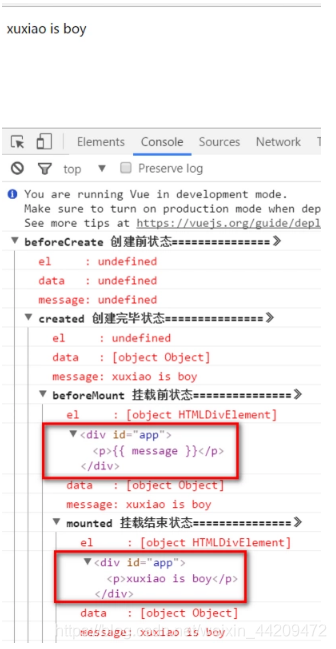vue生命周期及钩子函数理解
什么是vue?
Vue (读音 /vjuː/,类似于 view) 是一套用于构建用户界面的渐进式框架。与其它大型框架不同的是,Vue 被设计为可以自底向上逐层应用。Vue 的核心库只关注视图层,不仅易于上手,还便于与第三方库或既有项目整合。另一方面,当与现代化的工具链以及各种支持类库结合使用时,Vue 也完全能够为复杂的单页应用提供驱动。
vue钩子函数
1.beforeCreate 创建前执行(data和el都还未初始化)
2.created 完成创建 (完成了data数据初始化,el还未初始化)
3.beforeMount 载入前(完成了data和el数据初始化)
4.mounted 载入后html已经渲染(ajax请求可以放在这个函数中)
5.beforeUpdate 更新前状态(view层的数据变化前,不是data中的数据改变前)
6.updated 更新状态后
7.beforeDestroy 销毁前
8.destroyed 销毁后 (Dom元素存在,只是不再受vue控制)
下面以具体代码来直观介绍生命周期及钩子函数:
<!DOCTYPE html>
<html>
<head>
<title></title>
<script type="text/javascript" src="https://cdn.jsdelivr.net/vue/2.1.3/vue.js"></script>
</head>
<body>
<div id="app">
<p>{{ message }}</p>
</div>
<script type="text/javascript">
var app = new Vue({
el: '#app',
data: {
message : "xuxiao is boy"
},
beforeCreate: function () {
console.group('beforeCreate 创建前状态===============》');
console.log("%c%s", "color:red" , "el : " + this.$el); //undefined
console.log("%c%s", "color:red","data : " + this.$data); //undefined
console.log("%c%s", "color:red","message: " + this.message)
},
created: function () {
console.group('created 创建完毕状态===============》');
console.log("%c%s", "color:red","el : " + this.$el); //undefined
console.log("%c%s", "color:red","data : " + this.$data); //已被初始化
console.log("%c%s", "color:red","message: " + this.message); //已被初始化
},
beforeMount: function () {
console.group('beforeMount 挂载前状态===============》');
console.log("%c%s", "color:red","el : " + (this.$el)); //已被初始化
console.log(this.$el);
console.log("%c%s", "color:red","data : " + this.$data); //已被初始化
console.log("%c%s", "color:red","message: " + this.message); //已被初始化
},
mounted: function () {
console.group('mounted 挂载结束状态===============》');
console.log("%c%s", "color:red","el : " + this.$el); //已被初始化
console.log(this.$el);
console.log("%c%s", "color:red","data : " + this.$data); //已被初始化
console.log("%c%s", "color:red","message: " + this.message); //已被初始化
},
beforeUpdate: function () {
console.group('beforeUpdate 更新前状态===============》');
console.log("%c%s", "color:red","el : " + this.$el);
console.log(this.$el);
console.log("%c%s", "color:red","data : " + this.$data);
console.log("%c%s", "color:red","message: " + this.message);
},
updated: function () {
console.group('updated 更新完成状态===============》');
console.log("%c%s", "color:red","el : " + this.$el);
console.log(this.$el);
console.log("%c%s", "color:red","data : " + this.$data);
console.log("%c%s", "color:red","message: " + this.message);
},
beforeDestroy: function () {
console.group('beforeDestroy 销毁前状态===============》');
console.log("%c%s", "color:red","el : " + this.$el);
console.log(this.$el);
console.log("%c%s", "color:red","data : " + this.$data);
console.log("%c%s", "color:red","message: " + this.message);
},
destroyed: function () {
console.group('destroyed 销毁完成状态===============》');
console.log("%c%s", "color:red","el : " + this.$el);
console.log(this.$el);
console.log("%c%s", "color:red","data : " + this.$data);
console.log("%c%s", "color:red","message: " + this.message)
}
})
</script>
</body>
</html>
上述代码执行后 打开f12看生命周期中钩子函数不同时期的不同状态:

update相关
当在控制台输出app.message= ‘yes !! I do’;后 可以看到data里的值被修改后,将会触发update的操作

destroy相关
我们在console里执行下命令对 vue实例进行销毁。销毁完成后,我们再重新改变message的值,vue不再对此动作进行响应了。但是原先生成的dom元素还存在,可以这么理解,执行了destroy操作,后续就不再受vue控制了。
控制台输入app.$destroy();可以看到:

最后上一张比官网稍微详细的图参考:

- vue的生命周期钩子函数
- Vue生命周期函数的简单理解
- vue的生命周期及钩子函数
- vue2.0项目实战(4)生命周期和钩子函数详解
- 【Vue2.0】vue生命周期中的钩子函数
- vue生命周期、钩子理解
- vue生命周期中,钩子函数执行顺序
- Vue实例生命周期及钩子函数
- Vue提高篇-生命周期及其钩子函数
- vue生命周期中,钩子函数执行顺序
- Vue生命周期与钩子函数
- vue生命周期的钩子函数学习总结
- vue生命周期与钩子函数简单示例
- VUE生命周期中的钩子函数及父子组件的执行顺序
- Vue实例的生命周期和钩子函数
- vue生命周期钩子及组件
- vue生命周期函数
- vue生命周期理解
- vue生命周期函数
- Vue学习笔记3.2-生命周期函数 beforeCreate、created、beforeMount、Mounted、beforeUpdate、updated、beforeDestroy、destro
